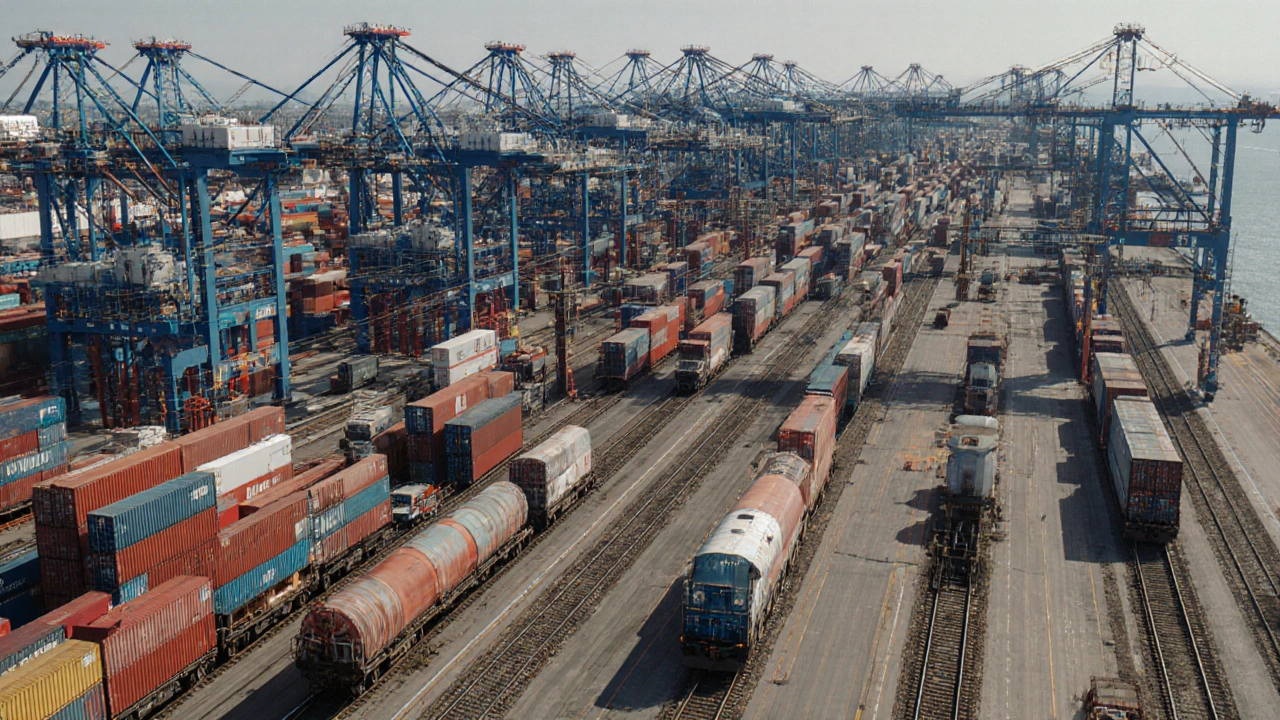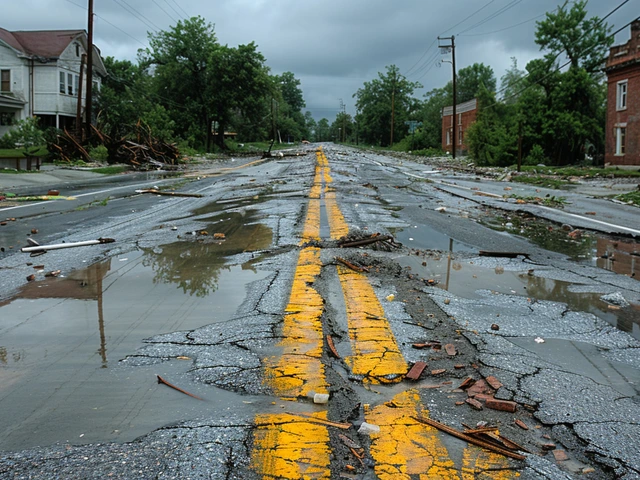When Port of Barcelona rolled out its first regular direct freight rail link to France on 8 November 2023, the logistics world took notice.
The inaugural train left the semi‑automated Hutchison Ports BEST terminal, heading for Toulouse with a follow‑up schedule that will see four departures each week – three round trips to Toulouse and one to Lyon, while Bordeaux will be served via a connecting service from Toulouse.
Behind the steel wheels sits a coalition of heavyweights: Maersk operates the service through its subsidiary APM Spain Railways, teaming up with Captrain, Naviland Cargo, Hutchison Ports BEST and Synergy. The initiative marks the first regular direct freight rail connection between Spain and France.
Why This Matters
The Iberian Peninsula has long been a bottleneck for European rail freight. Historically, goods crossing the Pyrenees had to swap locomotives or wheelsets at the border, a time‑consuming ritual that added days to a journey. By eliminating that step, the new service trims up to twelve days off the transit time compared with conventional sea routes that swing through northern ports.
"It has taken us many years and all the people present here have spent many years working to get where we are today," said Lluís Salvadó, President of the Port of Barcelona. His words echo a decades‑long push to modernise cross‑border logistics.
How the Service Works
Each train stretches 750 metres – the maximum length allowed on Europe’s standard gauge – and can haul 108 TEUs (20‑foot equivalent units). By contrast, the average convoy on the corridor measures about 500 metres and carries roughly 68 TEUs. The extra capacity translates into fewer train runs for the same volume of cargo, driving down both emissions and operating costs.
- Four weekly departures: three to Toulouse, one to Lyon.
- 750‑metre, 108 TEU trains – the longest allowed on the network.
- Seamless gauge from Barcelona to the French border, thanks to the port’s unique UIC European gauge connection.
- Interoperable locomotives supplied by Captrain and Naviland Cargo, removing the need for border swaps.
The route leverages the Perthus tunnel, the primary crossing through the Pyrenees, but with a twist: interoperable locomotives mean the train can cruise straight through without the historic bottleneck that once forced a stop‑and‑change routine.
Stakeholder Reactions
Industry analysts see the launch as a litmus test for broader European freight integration. "If Barcelona can make 750‑metre trains run reliably across the border, other corridors will follow," noted Maria Gonzàlez, senior transport analyst at EuroLogistics Insight.
Customers are already lining up. A major Spanish tyre manufacturer, Neuma Tires, confirmed it will shift 30 % of its French shipments to rail, citing cost savings and faster delivery windows.
On the French side, the regional council of Lyon praised the partnership, highlighting potential job creation at its logistics parks and a boost to the city's status as a multimodal hub.
Economic and Environmental Impact
By cutting transit times, shippers can reduce inventory holding costs – a hidden expense that often outweighs the freight price itself. Maersk estimates that the rail option could shave €200 million off the annual logistics spend for firms moving goods between the two nations.
Environmentally, the shift from sea to rail is significant. Trains emit roughly one‑third of the CO₂ per tonne‑kilometre compared with ships on the Mediterranean‑Northern Europe loop. Assuming the new service moves 10 % of the current maritime volume within its first year, that could equate to a reduction of about 45 000 tonnes of CO₂ annually.
Future Plans and Industry Implications
Maersk isn’t stopping at Barcelona. The company has announced plans to roll out similar rail corridors from Zaragoza and Tarragona, turning Spain into a rail freight hub that feeds directly into the broader European network.
If those projects materialise, the Iberian Peninsula could rival the Benelux region as the gateway for inland European trade, reshaping supply‑chain strategies that have long relied on maritime shipping lanes.
Policy‑makers are watching closely. The European Commission’s recent “Shift2Rail” initiative earmarks €1.2 billion for cross‑border rail improvements, and the Barcelona link could serve as a flagship model for future funding allocations.
Frequently Asked Questions
How does the new rail service affect Spanish exporters?
Exporters now have a faster, more reliable route to French markets, cutting lead times by up to twelve days. This translates into lower inventory costs and the ability to respond quicker to demand spikes, especially for time‑sensitive goods like automotive parts.
What makes the Barcelona‑France rail link different from previous attempts?
The key innovations are the 750‑metre train length, interoperable locomotives that eliminate border changes, and the port’s unique UIC gauge connection that runs straight to the French border, removing the technical hurdles that plagued earlier services.
Will this service reduce freight costs for consumers?
While savings are first felt by shippers, the lower transportation costs eventually trickle down, potentially lowering prices on imported goods like electronics, clothing, and automotive parts that travel the Spain‑France corridor.
How does the rail link impact the environment?
Rail emits roughly a third of the CO₂ per tonne‑kilometre compared with maritime routes. Shifting even 10 % of freight to rail could cut annual emissions by about 45 000 tonnes, supporting EU climate goals.
What are the next steps for expanding rail freight in Spain?
Maersk plans to launch similar corridors from Zaragoza and Tarragona, while the European Commission is expected to fund further cross‑border upgrades under its Shift2Rail program, potentially extending the network to Italy and the Balkans.







Surya Prakash
October 6, 2025 AT 00:33It's disheartening that Europe celebrates this "progress" while ignoring the carbon cost of building more rail infrastructure.
Sandeep KNS
October 6, 2025 AT 04:43The inauguration of a direct freight corridor between Barcelona and France is presented as a triumph of logistics engineering.
Yet one must ask whether the capital outlay for gauge harmonisation does not simply redistribute fiscal burdens onto the taxpayers of the Iberian Peninsula.
The touted twelve‑day reduction in transit time, while numerically impressive, is predicated on the assumption that demand will remain inelastic.
In reality, shippers are likely to recalibrate their supply chains, eroding the projected €200 million savings cited by Maersk.
Moreover, the environmental benefit, quantified as a 45 000‑tonne CO₂ reduction, appears modest when contrasted with the emissions generated during construction of the Perthus tunnel upgrades.
The reliance on interoperable locomotives, lauded as a technological marvel, merely masks the underlying incompatibility of national railway standards.
One cannot overlook the fact that the 750‑metre train length sits at the very limit of Europe’s infrastructure, leaving little room for future scalability.
The involvement of industry giants such as Maersk and Captrain inevitably raises concerns about market concentration and the marginalization of smaller operators.
While the French regional council hails the project for potential job creation, those positions are largely contingent upon the continued success of the corridor.
The European Commission’s Shift2Rail funding, though generous, risks becoming a subsidy for a pilot that may never achieve pan‑European relevance.
Historical attempts at cross‑border freight integration have repeatedly faltered due to bureaucratic inertia, a factor conspicuously absent from the press release.
The authors of the announcement appear blissfully unaware of the volatile nature of geopolitical trade agreements that could alter tariff structures overnight.
In addition, the reliance on a single corridor through the Pyrenees leaves the network vulnerable to disruptions caused by natural events or labor disputes.
One might also consider the opportunity cost: resources allocated here could have been invested in expanding inland waterways or modernising port automation.
In sum, the venture, while aesthetically appealing, warrants a more sober assessment beyond the veneer of progress.
Mayur Sutar
October 6, 2025 AT 08:53I think this link could really boost regional trade and give exporters more flexibility.
The shorter lead times mean companies can respond faster to market changes which is a big plus.
It also showcases how collaborative projects across borders can overcome historic bottlenecks.
Overall, it's a step toward a more integrated European supply chain.
Nancy Ortiz
October 6, 2025 AT 13:03From a modal‑shift perspective, the Barcelona‑France artery exemplifies an intermodal hub poised to alleviate maritime congestion.
However, the jargon‑laden promotional material glosses over the operational complexities inherent in cross‑border gauge harmonisation.
One can't help but chuckle at the rosy forecasts when the underlying infrastructure constraints remain largely unaddressed.
Adrish Sinha
October 6, 2025 AT 17:13Great step forward for greener logistics!
Arun kumar Chinnadhurai
October 6, 2025 AT 20:00Indeed, the 750‑metre trains can haul up to 108 TEUs, which translates to roughly a 60% increase in capacity per run compared to the previous 500‑metre convoys.
This upscaling reduces the number of required train paths, lowering both track wear and energy consumption.
Additionally, the interoperable locomotives eliminate the traditional locomotive change at the border, shaving hours off each journey.
From a cost perspective, Maersk's estimate of €200 million in annual savings stems largely from reduced dwell times and inventory carrying costs.
Environmental impact assessments also indicate a cut of approximately 45 000 tonnes of CO₂ per year if the service captures 10% of maritime volume.
Finally, the project's success could serve as a model for future corridors like Zaragoza‑Milan, fostering a broader shift toward rail freight across Europe.
Aayush Sarda
October 7, 2025 AT 00:10While Europe boasts about this new link, we must remember that India's own freight rail network moves millions of tonnes daily without the bureaucratic hassle of border swaps.
Our dedicated freight corridors already operate with standardized gauge and seamless locomotive transitions.
It's a shame that European policymakers chase after fresh projects instead of learning from proven models like ours.
Nevertheless, a friendly nod to Barcelona's effort can be appreciated as a small stride toward global rail integration.
Perhaps one day we'll see a true Indo‑European rail bridge that rivals these half‑measures.
Mohit Gupta
October 7, 2025 AT 02:56Wow!!! This is such an exciting development!!! I love how you highlighted the contrast!!! It really gets the blood pumping seeing different regions push forward!!! Can't wait to see more rail magic happen!!!
Varun Dang
October 7, 2025 AT 07:06The initiation of this direct freight rail service represents a notable advancement in supply‑chain efficiency.
By reducing transit times, companies can lower inventory holding costs and enhance responsiveness.
Moreover, the environmental benefits align with the EU's broader climate objectives.
Continued investment in such corridors will likely yield compounded economic and ecological gains.
Stavya Sharma
October 7, 2025 AT 11:16While the optimistic outlook is understandable, it overlooks the potential bottlenecks inherent in a single‑track corridor through the Pyrenees.
Any disruption, be it technical failure or labor dispute, could cascade into significant delays across the network.
Furthermore, the projected cost savings assume full utilization, which remains uncertain in the current market climate.
Stakeholders ought to conduct rigorous sensitivity analyses before heralding this as a panacea.
Only then can we justify the substantial public investment involved.
chaitra makam
October 7, 2025 AT 15:26This new rail link could be a game‑changer for businesses that rely on timely deliveries.
It's worth keeping an eye on how the service scales over the next year.
Erica Watson-Currie
October 7, 2025 AT 19:36In the grand tapestry of commerce, each thread of connectivity rewrites the narrative of distance.
Rail, as a conduit, whispers of a future where speed and sustainability converge.
Thus, we stand at the cusp of a subtle yet profound transformation.